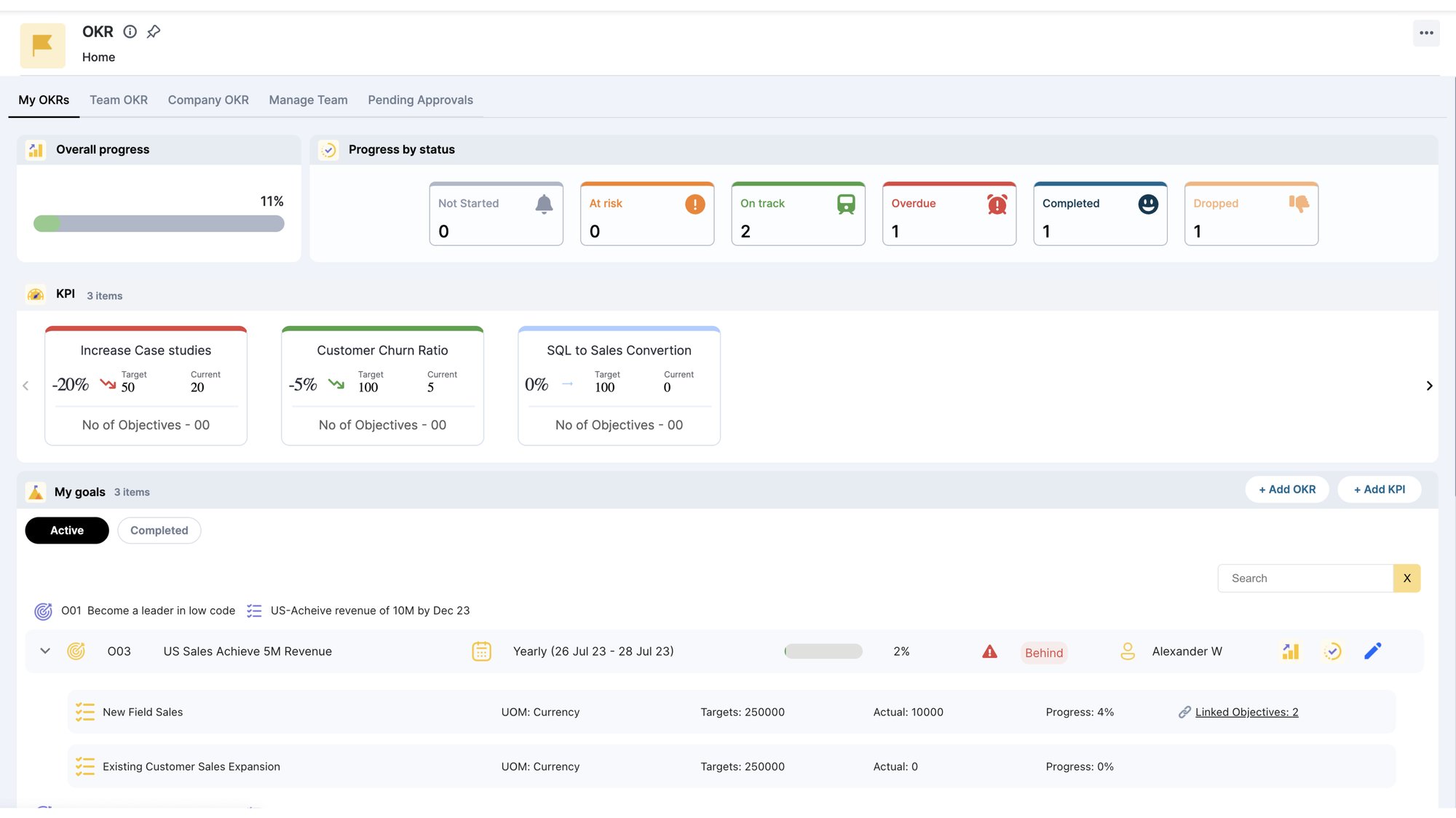Productivity is a common measure of how well we’re doing in each of those areas and relates to how efficiently a team is operating. Like most areas of leadership, productivity increases when an improvement on your team begins with your improvement as an individual.
We’ll look at six strategic ways to help your team be more productive in the workplace, followed by an additional seven simple but effective ways to increase your personal productivity at work.
How to increase the team’s productivity at work
1. Set realistic goals
Here we are talking about goals again! Really, we can’t emphasize this enough. You, your team, your whole company you all need good team goals that are understandable and attainable. Lack of well-defined goals and measures is a major contributor to project failure, accounting for 37% of failed projects according to one Project Management Institute survey.
Good goals are realistic, clear, and measurable. You can assess whether your goals are good by asking the following questions:
- Can we accomplish this goal with the time, resources, and project management skills we currently have? (Is it realistic?)
- Do we know exactly what is being asked of us? (Is it clear?)
- Are there quantifiable indicators with which we can judge our success around each goal? (Is it measurable?)
The goals you set for your team will be different from your individual goals of course. (You have mad individual goals, right?) During the project plan, don’t forget to get your team’s input on what their goals should be as a group and as individuals.
2. Monitor progress
When you plan your project, you establish key performance indicators (KPIs) in the form of,
- budgets
- project timelines and
- quality expectations.
During the course of your project, you should regularly check your KPIs and keep track of project progress so you can catch issues and make corrections quickly. Having good reporting tools greatly increases the accuracy and ease of monitoring. Don’t forget to celebrate successes when your KPIs tell you the team has achieved a goal.
3. Hold standing meetings
We already mentioned that you should avoid unnecessary meetings. When you really do need to have a group of people together to discuss something, consider making it a standing meeting. Sometimes called ‘standups’, a standing meeting is exactly what it sounds like: a meeting where everyone is standing.
The benefit of a standing meeting is that it reduces the tendency to waste time. If everyone is settled around a conference table, you’re more prone to chit-chat and to run off on tangents. In a standing meeting, everyone has the sense that the meeting is meant to be brief (it is), and they’ll stick to the subject at hand.
4. Create a healthy work environment
A positive work environment contributes to productivity in multiple ways such as the Pomodoro technique all of which contribute to increased productivity. When your team members are happy, they’re more likely to think creatively, take calculated risks, support their coworkers, and stay organized at work longer.
You can also have some productivity games to plan within teams that help to align them together.
5. Give your team the right tools
No matter how happy, committed, or skilled your team members are, they can benefit from having good tools at their disposal. The project management tool has come a long way in the past several years, and you should take advantage of it. The best project management software has Kanban boards and built-in collaboration tools that can keep you organized and boost efficiency. Moreover, integrating a client portal into your workflow can streamline communication and enhance collaboration, allowing for smoother project execution. For a companies using multiple tools, a password manager makes it easy by keeping all the login details safe and organized, so employees can access the tools quickly and securely without having to remember multiple passwords.
For a companies using multiple tools, a password manager makes it easy by keeping all the login details safe and organized, so employees can access the tools quickly and securely without having to remember multiple passwords.
For a companies using multiple tools, a password manager makes it easy by keeping all the login details safe and organized, so employees can access the tools quickly and securely without having to remember multiple passwords.
6. Share these tips with your team
Why keep good information to yourself? Educate your team by sharing the above productivity tips with them. Maybe gamify your team’s productivity at work by having a doodling contest during breaks or seeing who can go the longest without checking his phone.
Now that you’ve learned how to ramp up your team’s productivity as well, let’s discuss how to be more productive at work as an individual as well.
How to increase productivity at work as an individual
1. Learn to prioritize
Most people end up as project managers because they are good at getting things done. Then you become a project manager and are suddenly expected to get more things done in the same amount of time. How do you decide what to tackle first? One simple tool for prioritizing is the Eisenhower Matrix.
Also known as the Urgent-Important Matrix, this method helps you prioritize tasks based on their levels of urgency and importance. Tasks fall into one of four categories:
- Urgent and important
- Not urgent, but important
- Not important, but urgent
- Not urgent and not important
It’s helpful to visualize your Eisenhower Matrix by drawing a simple chart. Make the Eisenhower Matrix a regular part of your routine, and commit to following through and the insights your gain.
2. Schedule your day strategically
Some people arrive at the office full of energy, and some of us need an hour and a cup of coffee before our brains are fully operational. Take note of when you’re most productive at work, and schedule the most difficult tasks for those times.
If the post-lunch slump always gets you, use that time to check emails or pop into a coworker’s office to touch base (only make sure you don’t interrupt her most productive time in the process!).
3. Delegate
One of the biggest challenges of project management is realizing that you cannot do it all. You may have been made project manager because you’re really good at getting things done.
That’s great! But now there are many more things for which you’re responsible. If tasks are piling up, access which ones must be done by you and delegate tasks that can be passed to someone else.
4. Reduce distractions
We live in a distraction-filled world, and whether we realize it or not, all those distractions are killing our productivity. So turn off the email notifications, set your phone to silent, and hang a ‘do not disturb’ sign on your door.
If it’s impossible to focus in your actual office, carve out time elsewhere each day, whether that’s a coffee shop up the road, an unused conference room, or a janitor’s closet where no one will think to look for you.
5. Stop multitasking
Multitasking is a myth. Scientific research has demonstrated that multitasking is actually switching rapidly between tasks and that it costs us time and energy each time we switch. So instead of doing two (or more) things at once, with the help of task management, tackle your to-do list one item at a time and don’t move on until an item is completed.
6. Take breaks
While it may feel counterproductive to take breaks, studies show that taking breaks can increase productivity. Breaks are also good for your physical and mental health and can help re-energize you for the task at hand.
One exception is that when you’re in a ‘flow’– a state of effortless productivity– it’s best not to interrupt yourself. Otherwise, go for a walk, grab a coffee, water your office plants, and then come back refreshed.
7. Have fewer meetings
Meetings are necessary for project management, and some of us actually like meetings. Weird, I know. However, having too many meetings can steal time from work on the project itself. And, let’s be honest, our meetings far too often go long, get off-topic, and don’t result in the answers we were hoping for.
Before scheduling or accepting a meeting, ask yourself whether its goals could be accomplished with an email or phone call, and do your best to avoid unnecessary meetings.
Do more in less time using productivity tools
Our whole discussion about productivity at work can be understood in terms of individual and team-building activities. Goal setting, prioritization, and personal schedule management are some project management skills anyone on your team can learn and implement on his own.
As the project manager, you have the ability to give your team additional productivity tools in the form of well-timed meetings, kanban boards, effective goal setting and monitoring, good project management software, and a healthy work environment.
Whether you’re managing your first project or your thousandth, having an online project management software like Kissflow Project can help make these simple changes can increase productivity for you and your team.
More Resources
- The Ivy Lee Productivity Method: A Definitive Guide for Better Productivity
- What are some of the productivity killers and how to face them
- The Task Batching Method: A Definitive Guide for Better Productivity
- The Eisenhower Matrix: A Definitive Guide for Better Productivity
- Eat the Frog Method: A Definitive Guide for Better Productivity
- Why Pomodoro technique is the go-to productivity technique in 2022

.png?width=2000&name=admin%20dashboard%20(2).png)










